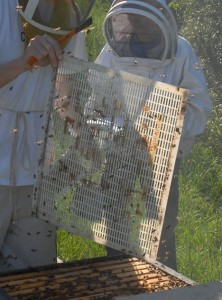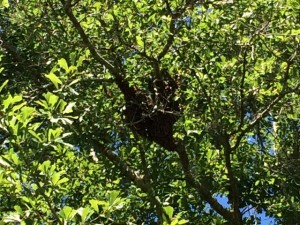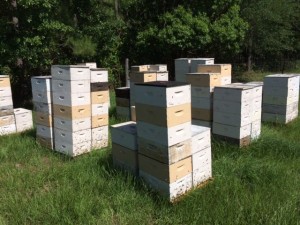The options for beekeeping equipment are seemingly endless. Lids, hive tools, suits, smokers, pallets or bottom boards; even backyard beekeepers need a lot of stuff. But how much of this equipment is really necessary? The answer is probably not much, but it definitely makes certain aspects of beekeeping easier. Today I want to look at one piece of equipment in particular, the excluder. Over the years I’ve heard many views on whether or not they are necessary, financially worth it or good for a hive (and of course the only thing beekeepers have more of than equipment is opinions). Called honey excluders or queen excluders (depending on where you’re from and what type of operation you run), excluders are used to restrict the queen to the bottom of the hive, usually one or two hive bodies, called the brood chamber. There are several reasons why a beekeeper would use an excluder. The first is for honey production. When removing honey supers you don’t want to worry about pulling a box of brood to extract. The comb in honey supers is much lighter because it has never had brood (and light colored wax fetches a higher price). An excluder also makes it significantly easier to find the queen.

I personally run excluders on my bees as my operation is generally for solely honey production. One of the thoughts I’ve heard regarding the use of queen excluders is that they make more honey and swarm less without them. After hearing many strong feelings on the subject, several weeks I decided to conduct a mini experiment on my own bees with three (very related) questions in mind:
- Does the use of an excluder encourage swarming?
- Is the queen more productive without an excluder?
- Do bees without an excluder make more honey?
The gallberry honey flow was about to start in North Florida so I figured this was the best time to start. I run all 8 frame 7¾ boxes and usually use two as the brood chamber and have two supers above the excluder. One week before the major flow came on, I removed excluders from 40 randomly selected colonies. 12 days later I came back to undersuper and check on the progress. In terms of honey production there was no significant difference each had made about two boxes. Of course the queen had moved up to lay in the top two boxes but fortunately the most of the pupae in the original brood chamber had hatched out so she moved back down. I wasn’t too worried about the brood up top because it would be at least several weeks before I pulled honey providing ample time for hatch out as well as backfilling the empty cells with honey. At this point I realized exactly how big a mess I had on my hands and how much extra work I’ve put on myself. I panicked and put the excluders back on with the queen in her rightful place 7 days later I returned to undersuper again and noticed a definite difference between colonies that had excluders removed and those that didn’t. It was immediately apparent that the colonies that had excluders the entire time had a much higher incidence of swarming. In fact, none of the excluder-less hives had swarmed. There are two more weeks of honey flow with no “weigh-ins” but it looks like excluder-less bees will win. Not only did they not swarm, the queen had on average 5 more frames of brood so the populations will be greater. Whether or not it will be worth the additional work is another question.


Summary:
- Does the use of an excluder encourage swarming? From my experience, an excluder can definitely make the bees feel plugged down. Bees seem to prefer to swarm after a major honey flow rather than during it but if a hive does swarm, you can bet it won’t make more honey, so not only have you lost half your bees, you also lost your honey crop. Rather than allowing the queen free range of the hive, perhaps temporarily increasing the size of the brood chamber will make the bees feel less congested.
- Is the queen more productive without an excluder? With more space to brood up, the queen can lay significantly more if she has a larger area, boosting hive population.
- Do bees without an excluder make more honey? Excluders don’t seem to be an immediate hindrance to honey production. Factors such as swarming behavior and hive population are much more influential on overall production.
So as you can read, this little experiment was in no way very scientifically executed but still telling nonetheless. The decision to use excluders is entirely relative to the needs of the beekeeper. A backyard beekeeper with a couple hives in the backyard may want to use excluders to make finding the queen easier but a commercial beekeeper who works almost solely in pollination rather than honey production may not want the hassle and expense of excluders. I’d love to see your comments and questions, so post your take on excluders below!